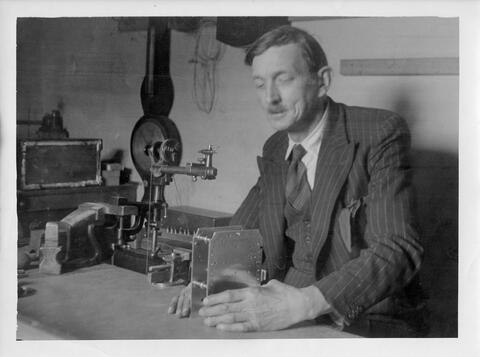
Zone d'identification
Type d'entité
Forme autorisée du nom
forme(s) parallèle(s) du nom
Forme(s) du nom normalisée(s) selon d'autres conventions
Autre(s) forme(s) du nom
Numéro d'immatriculation des collectivités
Zone de description
Dates d’existence
Historique
Henry Draisey (1896–1975) was a clockmaker and Fellow of the British Horological Institute from 1953/54. He began his clockmaking career in 1920 with Niehus Bros of 39-40 Bridge Street in Bristol, ‘manufacturers of English church, turret and factory clocks’, both locally and for international markets. From a 1931 reference letter, we know that he ‘undertook the work of supervising and estimating for inside and outside work including the making and repairs of turret clocks. Mr Niehus considered him a first-class workman and had complete confidence in him.’
Presumably while working at Niehus, Henry assisted an amateur maker, Mr Mosely (an engineer from Bristol) to make a longcase clock designed to demonstrate Grimthorpe’s gravity escapement. Mosely was 82 when the project was started in 1923, and it took three years to complete. Draisey would encounter the clock again later in life.
Mr Niehus’s poor health led to the closure of the firm and Henry’s redundancy in late 1931. He then worked on his own as a clockmaker through the Great Depression.
From 30 June 1947, he worked for Pleasance and Harper, also in Bristol, a firm that described him in a reference of May 1951 as ‘perfectly honest and a thoroughly experienced clockmaker, able to undertake complicated and difficult work’. While working for the firm, Ernest G. Harper, chair of Pleasance and Harper, submitted an application form to the BHI on Henry’s behalf in January 1949, commenting on his significant skills (‘he can make any part of any size for any type of clock’), and the fact his own workshop staff begged him to employ Henry ‘for what they can learn from him’. Harper suggested he should be considered for the award of a Fellowship of the Institute, as he ‘would pass with flying colours any exam either practical or theoretical’. Henry duly transferred from CMBHI to FBHI in 1952 (Horological Journal, November 1952). While still at Pleasance and Harper, the Moseley clock was cleaned by the firm, and transferred to the Mansion House in Bristol.
Finally, Henry worked for Llewellin’s Machine Company, working on timekeeping equipment in all areas, including watchman’s clocks and time recorders, though he clearly had a long independent career working in clocks.
Lieux
Statut légal
Fonctions et activités
Textes de référence
Organisation interne/Généalogie
Contexte général
Zone des relations
Zone des points d'accès
Mots-clés - Sujets
Mots-clés - Lieux
Occupations
Zone du contrôle
Identifiant de notice d'autorité
Identifiant du service d'archives
Règles et/ou conventions utilisées
Statut
Niveau de détail
Dates de production, de révision et de suppression
Langue(s)
Écriture(s)
Sources
Henry Draisey’s biography was compiled by James Nye, with information provided by Mark Draisey, Henry’s grandson.
Image courtesy of Mark Draisey.